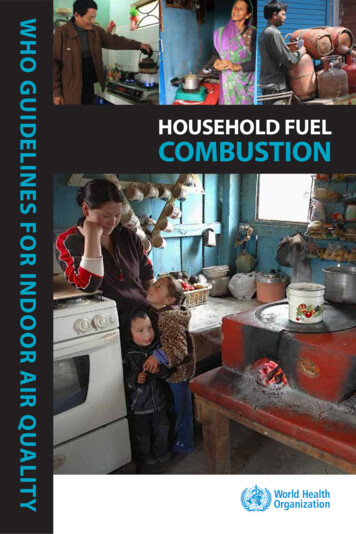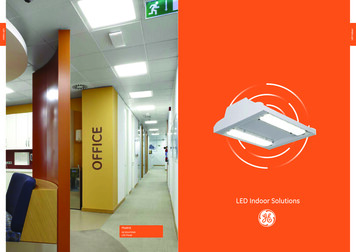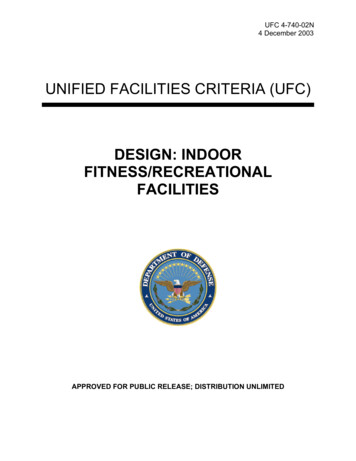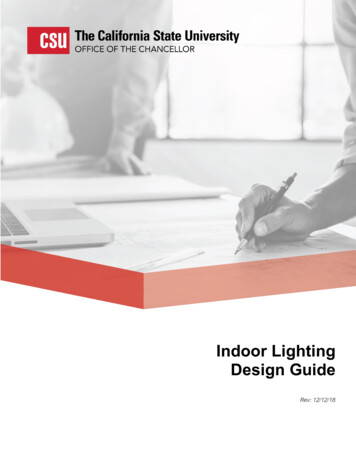
Transcription
HOUSEHOLD FUELWHO GUIDELINES FOR INDOOR AIR QUALITYCOMBUSTION
WHO guidelines forindoor air quality:household fuel combustion
WHO indoor air quality guidelines: household fuel combustion.1.Air Pollution, Indoor. 2.Environmental Exposure. 3.Household Products – adverse effects.4.Guideline. I.World Health Organization.ISBN 978 92 4 154887 8 (print)ISBN 978 92 4 154888 5 (CD-ROM)(NLM classification: WA 754) World Health Organization 2014All rights reserved. Publications of the World Health Organization are available on the WHOwebsite (www.who.int) or can be purchased from WHO Press, World Health Organization, 20Avenue Appia, 1211 Geneva 27, Switzerland (tel.: 41 22 791 3264; fax: 41 22 791 4857; e-mail:bookorders@who.int).Requests for permission to reproduce or translate WHO publications –whether for sale or fornon-commercial distribution– should be addressed to WHO Press through the WHO website(www.who.int/about/licensing/copyright form/en/index.html).The designations employed and the presentation of the material in this publication do not implythe expression of any opinion whatsoever on the part of the World Health Organization concerning the legal status of any country, territory, city or area or of its authorities, or concerning thedelimitation of its frontiers or boundaries. Dotted and dashed lines on maps represent approximate border lines for which there may not yet be full agreement.The mention of specific companies or of certain manufacturers’ products does not imply thatthey are endorsed or recommended by the World Health Organization in preference to others ofa similar nature that are not mentioned. Errors and omissions excepted, the names of proprietaryproducts are distinguished by initial capital letters.All reasonable precautions have been taken by the World Health Organization to verify theinformation contained in this publication. However, the published material is being distributedwithout warranty of any kind, either expressed or implied. The responsibility for the interpretation and use of the material lies with the reader. In no event shall the World Health Organizationbe liable for damages arising from its use.Printed by the WHO Document Production Services, Geneva, SwitzerlandCover photos:Front, top (left to right): M. Wright/Ashden Awards; J. Lewis/Duke University; N. Bruce/WHO,bottom: N. Bruce/WHOBack: N. Bruce/WHO
WHO guidelinesfor indoor air quality:household fuel combustion
WHO INDOOR AIR QUALITY GUIDELINES: HOUSEHOLD FUEL COMBUSTIONiv
ContentsForeword viiGlossary ixAcknowledgements xiiExecutive summary xiv1. Introduction 11.1 The health burden from household fuel combustion 11.2 Scoping questions 91.3 WHO guidelines relating to this topic 91.4 Target audience 102. Guideline development process 112.1 Scope of the guidelines 112.2 Evidence review 122.3 From evidence to recommendations 243. Individuals and partners involved in the development of theseguidelines 313.1 WHO steering group (SG) 313.2 Guideline development group (GDG) 313.3 External peer-review group (EPRG) 323.4 Management of conflicts of interest 324. Recommendations 334.1 Focus of recommendations 334.2 General considerations 334.3 Recommendation 1: Emission rate targets 344.4 Recommendation 2: Policy during transition to technologies andfuels that meet WHO air quality guidelines 414.5 Recommendation 3: Household use of coal 484.6 Recommendation 4: Household use of kerosene (paraffin) 534.7 Good practice recommendation: securing health andclimate co-benefits 55v
WHO INDOOR AIR QUALITY GUIDELINES: HOUSEHOLD FUEL COMBUSTION5. Implementation of the guidelines 595.1 Introduction 595.2 Approach to implementation: collaboration and the role of thehealth sector 595.3 Needs assessment 605.4 Intervention options and strategies 615.5 Policy for effective and sustained adoption 665.6 Standards, testing and regulation 675.7 Monitoring and evaluation: assessing the impact of these guidelines 685.8 Research needs 736. Updating the guidelines 756.1 Web-based updates 756.2 Updates based on substantial new evidence 75Annex 1: Steering, advisory and external review groups 79Annex 2: Summary of conflict of interest (COI) management 89Annex 3: Summary of evidence reviews 93Annex 4: Recommendation 1 – Emission rate targets: assessment ofthe quality of the evidence and strength of the recommendation 101Annex 5: Recommendation 2 – Policy during transition: assessment ofthe quality of the evidence and the strength of the recommendation 103Annex 6: Recommendation 3 – Household use of coal: assessment of thequality of the evidence and setting the strength of the recommendation 132Annex 7. Recommendation 4 – Household use of kerosene: assessmentof the quality of the evidence and setting of the strength of therecommendation 138Annex 8: Policy considerations for the best-practice recommendationon climate co-benefits 143Annex 9: International standards and testing facilities 144vi
ForewordEnergy use in the home is a vital and ubiquitous feature of human society. Energyis used for a wide variety of purposes, including cooking, space heating, lighting, small-scale income generation, various household tasks, and entertainment.Although all home energy use can impact health in various ways, globally by farthe most important direct health risk is household air pollution caused by theincomplete combustion of fuel in low-efficiency stoves and lamps used for cooking, space heating and lighting. For the year 2012, the World Health Organization(WHO) estimated that close to 3 billion people, mostly in low- and middleincome countries (LMICs), lacked access to clean or modern energy services forcooking resulting in some 4.3 million premature deaths worldwide.Clean air in and around the home is essential to a healthy life. WHO has along tradition in synthesizing the evidence on health aspects of air quality and inpreparing technical recommendations to ensure clean and healthy air both in theindoor and outdoor environments. This volume, the third in the series, followingindoor air quality guidelines for selected pollutants and for dampness and mould,provides technical recommendations on the requisite performance of the fuelsand technologies used in the home. These guidelines recognize the challengesfaced by Member States when trying to implement household energy interventions, and provide guidance on the best approaches for securing rapid adoptionand sustained use of low emission household energy technologies and fuels toprotect health.These new guidelines are particularly timely as the global community transitions toward a more sustainable and equitable future, guided by the post-2015sustainable development framework. Currently, although there are many globaland national initiatives aimed at ensuring access for all households to clean andmodern energy, there is a lack of clarity about what technologies and fuels can beconsidered clean and safe.Elimination of the substantial inequalities in energy access and air quality in and around the home that exist in the world today will bring substantialhealth and development benefits. These new guidelines will inform policy- and decision-makers in the health sector and in other sectors, as well as researchersand technical staff, when designing and implementing interventions to addressthis problem.The guidelines were developed and peer-reviewed by scientists from all overthe world and the recommendations were informed by a rigorous review of allcurrently available scientific knowledge on this subject. I would like to thankvii
WHO INDOOR AIR QUALITY GUIDELINES: HOUSEHOLD FUEL COMBUSTIONthese experts for their work in developing a product which I believe can stimulate a major new effort to improve global health.Dr Margaret ChanDirector-GeneralWorld Health Organizationviii
GlossaryCombustion, air pollution and health related terminologyTermAcronym Explanationhousehold air pollutionHAPAir pollution generated by household fuel combustion, leading to indoor air pollution, and contributing to ambient airpollution.ambient air pollutionAAPAir pollution in the ambient environment, that is, in outdoorair, but able to enter homes.acute lower respiratory infectionsALRIAcute illness affecting the lungs, such as acute bronchitis andbronchiolitis, influenza and pneumonia.WHO air quality guidelineAQGValue at or under which a pollutant is considered to have no,or minimal impact on health.carbon monoxideCOColourless, odourless, toxic gas produced by incompletecombustion of carbon-containing materials.chronic obstructivepulmonary diseaseCOPDA collection of chronic lung conditions characterized primarily by a persistent blockage of airflow from the lungs.cardiovascular diseaseCVDDisorders of the heart and blood vessels including diseaseof the coronary blood vessels supplying the heart (coronaryheart disease) and the blood vessels supplying the brain(cerebrovascular disease).greenhouse gasesGHGsGas compounds in the atmosphere that absorb and emitradiation within the thermal infrared range.integrated exposure-responsefunctionIERModels that combine exposure and risk data for four sourcesof combustion-related pollution, namely outdoor air, secondhand smoke, household air pollution and active smoking.ischaemic heart diseaseIHDDisease characterized by reduced blood supply to the heart.interim target-1IT-1A pollutant level higher than that set by the AQG, established as an interim target to assist implementing agenciesto make progress towards meeting the AQG levels.products of incomplete combustion PICsMixtures of pollutant particles and gases formed by incomplete burning of fuels or other material.particulate matterPMA mixture of solid particles and liquid droplets suspendedin the air.respirable particulate matterPM10Particles (complex mixtures of pollutants) with aerodynamicdiameters of 10 µm or lessfine particulate matterPM2.5Particles with aerodynamic diameters of less than 2.5 µmtuberculosisTBInfectious disease caused by Mycobacterium tuberculosis,which most commonly affects the lungs.vector-borne diseaseVBDInfectious disease caused by microbes transmitted to peopleby blood-sucking arthropods (insects or arachnids).solid biomass fuel–Wood, animal dung, crop wastes and charcoal used as fuel.solid fuel–Solid materials burned as fuels, includes coal as well asbiomass fuels.ix
WHO INDOOR AIR QUALITY GUIDELINES: HOUSEHOLD FUEL COMBUSTIONAdditional acronyms and abbreviationsxAcronymExplanationCCTControlled cooking testCRAComparative risk assessmentEPRGExternal peer-review groupGDGGuidelines development groupGEPHIGrading of Evidence for Public Health InterventionsGRADEGrading of Recommendations Assessment, Development and EvaluationIARCInternational Agency for Research on CancerITTIntention to treatISOInternational Organization for StandardizationIWAInternational Workshop AgreementKPTKitchen performance testLMICsLow- and middle-income countriesLPGLiquefied petroleum gasM&EMonitoring and evaluationNGOsNongovernmental organizationsOROdds ratioRCTsRandomized controlled trialsRRRelative riskSGSteering groupSHSSecond-hand smokeSRMASystematic review and meta-analysisUNUnited NationsUNEPUnited Nations Environment ProgrammeWBTWater boiling test
Major policy and implementation agencies and initiativesTermAcronymExplanationClimate and Clean Air CoalitionCCACA UNEP-led partnership of governments and UN andother agencies, with the goal of securing combinedhealth and climate benefits from reduction of shortlived climate pollutants.http://www.unep.org/ccac/Department for InternationalDevelopmentDFIDUnited Kingdom development cooperation agency.https://www.gov.uk/dfidUnited Nations Foundation GlobalAlliance for Clean CookstovesGACCAn alliance of public and private partners established by the UN Foundation in 2010 to address theglobal problems associated with traditional sche Gesellschaft fürGIZInternationale Zusammenarbeit GmbHGerman development cooperation agency.http://www.giz.de/en/Indian Council of Medical ResearchICMRIndian medical research body.http://icmr.nic.in/International Energy AgencyIEAAn autonomous organization working in the field ofenergy.http://www.iea.org/International Organization forStandardizationISOA nongovernmental organization and network of thenational standards organizations.http://www.iso.org/Sustainable Energy for AllSE4AllAn initiative of the UN Secretary-General to develop apublic-private partnership to achieve universal accessto modern energy services by 2030.http://www.sustainableenergyforall.org/xi
WHO INDOOR AIR QUALITY GUIDELINES: HOUSEHOLD FUEL COMBUSTIONAcknowledgementsThe development of these guidelines was coordinated by Nigel Bruce, HeatherAdair-Rohani and Elisa Puzzolo, under the supervision of Dr Carlos Dora(Department of Public Health, Environmental and Social Determinants ofHealth, WHO).The guidelines had a WHO steering group with the following members:Heather Adair-Rohani, Sophie Bonjour, Nigel Bruce, Jennifer De France, CarlosDora, Arunachalam Gunasekar, Marie-Eve Heroux, Michal Krzyzanowsky, MohdNasir Hassan, Mazen Malkawi, David Meddings, Kate Medlicott, Mariam Otmandel Barrio, Payden, Annette Pruss-Ustun, Nathalie Roebbel, Agnes Soares DaSilva, Kutane Waltaji Terfa, Martin Weber, and Raki Zghondi (please see Annex1 for affiliations).The members of the project’s Guideline Development Group (GDG) were:Kristin Aunan, Kalpana Balakrishnan (co-chair), John Balmes, Michael Bates,Michael Brauer, Kenneth Bryden, Aaron Cohen, Mukesh Dherani, ShaneDiekman, Xiaoli Duan, Rufus Edwards, Elizabeth Fisher, Santu Ghosh, HenockSolomon, Kirstie Jagoe, Michael Johnson, Nathan Johnson, Sunny Karnani, QingLan, Claudio Lanata, Weiwei Lin, John McCracken, Sumi Mehta, Lidia Morawska(chair), Luke Naeher, Mark Nicas, Michael Peck, Daniel Pope, Elisa Puzzolo, EvaRehfuess, Kirk R Smith, Debbi Stanistreet, James Tielsch, Hisham Zerriffi, andJunfeng Zhang (see Annex 1 for affiliations).Three members of the GDG represented interests of users, namely SumiMehta (through the UN Foundation Global Alliance for Clean Cookstoves),Kalpana Balakrishnan (through cooperation with the Indian Council of MedicalResearch and the Indian Improved Cookstove Programme), and Xiaoli Duan(through cooperation with the national government of China).The project’s External Peer Review Group (EPRG) had the following members: Ryan Allen, Ross Anderson, Jill Baumgartner, Tami Bond, Ranyee Chiang,Randy Elder, Morgan de Foort, Judy Guernsey, Andrew Grieshop, Guy Hutton,Marc Jeuland, Veena Joshi, Jacob Kithinji, Omar Masera, Daniel Mausezahl,Christoph Messinger, Rogelio Perez-Padilla, Tom Potokar, Mike Sage, and LinweiTian (see Annex 1 for affiliations).We would like to acknowledge the contributions made by Margaret Harris(consultant in WHO guideline methodology, who provided advice on the guideline development process and assisted with development of this document), andby Eileen Tawffik and Pablo Perenzin (WHO assistants who offered administrative support).xii
We also wish to thank Dr VM Katoch and Dr RS Dhaliwal of the IndianCouncil of Medical Research for hosting the main GDG expert group meeting inDelhi, April 2012.Sources of fundingThe guidelines project was funded by Deutsche Gesellschaft für InternationaleZusammenarbeit (GIZ) GmbH, Health Canada, The Indian Council forMedical Research (ICMR), the United Nations Foundation Global Alliancefor Clean Cookstoves (GACC) and the UK Department for InternationalDevelopment (DFID).xiii
WHO INDOOR AIR QUALITY GUIDELINES: HOUSEHOLD FUEL COMBUSTIONExecutive summaryAlmost 3 billion of the world’s poorest people still rely on solid fuels (wood,animal dung, charcoal, crop wastes and coal) burned in inefficient and highlypolluting stoves for cooking and heating, currently resulting in some 4 millionpremature deaths annually among children and adults from respiratory and cardiovascular diseases, and cancer. Together with widespread use of kerosene stovesand lamps, these household energy practices also cause many deaths and serious injuries from scalds, burns and poisoning. The use of solid fuel for heatingin more developed countries is also common and contributes significantly to airpollution exposure. Air pollution from household fuel combustion is the mostimportant global environmental health risk today.These new guidelines bring together the most recent evidence on fuel use,emission and human exposure levels, health risks, intervention impacts and policy considerations, to provide practical recommendations to reduce this healthburden, which build on existing WHO air quality guidelines (AQGs) for specific pollutants. Implementation of these recommendations will also help securethe additional benefits to society, development and the environment – includingclimate – that will result from wider access to clean, safe and efficient householdenergy.Drawing on a broad range of newly commissioned, or recently published,systematic reviews of the scientific literature, the guidelines apply strict criteriafor assessing the quality of available evidence and the suitability for developingrecommendations. Among the key findings is that for several important healthoutcomes, including child acute respiratory infections, exposure to the key pollutant – fine particulate matter, or PM2.5 – needs to be brought down to lowlevels in order to gain most of the health benefit. The other main finding is thatmost of the solid fuel interventions promoted in recent years have not even comeclose to these levels when in everyday use, and there is a need for much moreemphasis on accelerating access to clean household fuels.The recommendations focus particular attention on reducing emissions ofpollutants as much as possible, while also recognizing the importance of adequateventilation and information and support for households to ensure best use oftechnologies and fuels. They encompass general considerations for policy, a setof four specific recommendations, and a good practice recommendation foraddressing both health and climate impacts. The general considerations addressissues such as the need for community-wide action, as pollution from one houseor other sources affects neighbours, and vice-versa, and the fact that safety of newxiv
fuels and technologies cannot be assumed and must be assessed. The specific recommendations address the following: emission rate targets which specify the levels of emissions from householdenergy fuels and technologies that pose minimal health risks, and which aredesigned to guide assessment of how well various interventions can meet theair quality concentrations specified in WHO guidelines; policies for the period of transition from current practices to community-wideuse of clean fuels and household energy technologies, recognizing that intermediate steps will be needed for some time to come among lower income andmore rural homes reliant on solid fuels; the need to avoid the use of unprocessed coal as a household fuel, in light ofthe specific health risks; the need to avoid the use of kerosene as a household fuel, in light of concernsabout emissions and safety.The good practice recommendation encourages policy-makers to recognizethat many of the pollutants from household fuel combustion lead to both healthrisks and climate change.The guidelines are targeted at public health policy-makers and specialistsworking with the energy, environment and other sectors to develop and implement policy to reduce the adverse health impacts of household fuel combustion.This publication is linked to ongoing work by WHO and its partners to provide technical support for implementation of the recommendations, as well asmonitoring progress and evaluating programme impacts, for example, throughthe WHO database on household fuel combustion. Further details of the guidance, tools and other resources are available on the guidelines web pages: http://www.who.int/indoorair/guidelines/hhfc.xv
WHO INDOOR AIR QUALITY GUIDELINES: HOUSEHOLD FUEL COMBUSTIONxvi
1. Introduction1.1 The health burden from household fuel combustionWell into the 21st century, 2.8 billion people (Figure 1.1) still rely on solid fuels(wood, dung, crop wastes, charcoal, coal, etc.) and simple stoves for cooking andheating (Figure 1.2), and 1.2 billion light their homes with simple kerosene lamps(Figure 1.3) (1). Many studies show that these household energy practices resultin very high levels of household air pollution (HAP). Global burden of diseaseestimates have found that exposure to HAP from cooking results in around 4 million premature deaths (2,3), with the most recent estimates from WHO reporting4.3 million deaths for 2012. (4). HAP is responsible for nearly 5% of the globaldisease burden (expressed as disability-adjusted life-years (DALYs)), making itglobally the single most important environmental risk factor (3).HAP is also a substantial contributor to outdoor air pollution-related deathsdue to emissions into the ambient environment, responsible for around 0.4 million deaths (12% of the total from ambient air pollution (AAP)) (3).These household energy practices are also linked to a high risk of burns (e.g.from children falling into fires, spilled fuel, etc.) and poisoning (mainly from childreningesting kerosene) (Figure 1.4). Women and children may also be at risk for injuryand violence during fuel collection. Fuel gathering may take many hours per week,limiting other productive activities and taking children away from school (Figure 1.5).Figure 1.1, developed from WHO’s household energy database (5), shows theglobal extent of reliance on solid fuels for cooking and how this is concentratedin low and middle-income countries (LMICs) across Asia, Africa and LatinAmerica. More than 95% of the population uses solid fuels for cooking in a significant number of countries, most of which are in sub-Saharan Africa.Figure 1.1: Percentage of population relying on solid fuels as the primary cooking fuel in2012, by countrySource: WHO (5)1
WHO INDOOR AIR QUALITY GUIDELINES: HOUSEHOLD FUEL COMBUSTIONData for heating and lighting fuels are currently less complete and are notincluded in Figure 1.1. Further information on the distribution of fuels and technologies for these other household energy requirements, including the use ofother sources of combustion pollution such as insect repellent coils, is providedin Review 1, available at: : N.Bruce/WHOFigure 1.2: Exposure of family members to household air pollution (HAP) from cookingand heatingPhoto: N.Bruce/WHOPhoto: N.Bruce/Practical Action(a) Women and young children receive the highest exposure because they spend the most time in or near thekitchen when the stove is alight.(b) Other members of the family are also exposed, (c) The concentrations of pollutants in the homeincluding men, the elderly and the sick.commonly reach very high levels, hundreds or moretimes WHO guideline levels for important pollutantssuch as fine particles.2
1. IntroductionPhoto: N.Bruce/Practical ActionFigure 1.3: Exposure from lighting and other household activities involving fuelcombustionPhoto: N.Bruce/WHOPhoto: N.Bruce/WHO(a) Kerosene lamps are the most common form of lighting among 1.2 billion people with no electricity and formany others for whom electricity supply is intermittent, inadequate and/or unaffordable. These simple lamps emithigh levels of health damaging pollutants and pose a risk for fires.(b) Other sources of combustion pollution in and around (c) Another source of exposure are teh steam bathsthe home include preparing animal feed and burning common in Central America (temescales), locatedwaste.near the home and typically used several times perweek; these can result in very high levels of exposure topollutants, including carbon monoxide.3
WHO INDOOR AIR QUALITY GUIDELINES: HOUSEHOLD FUEL COMBUSTION(a) Kerosene is typically bought in small quantities,often in soft drink bottles; young children are at risk ofdrinking the fuel, leading to many cases of poisoning.(b) Many deaths, and much larger numbers ofphysically and mentally debilitating injuries, are causedby burns from solid fuel stoves and kerosene stoves andlamps. Scalds are also common, as pots with hot foodand liquid on simple stoves on the floor of the home areeasily knocked over by young children, especially wherethe home is poorly lit.4Photo: D. O’Neill/HELPSPhoto: N.Bruce/WHOFigure 1.4: Safety risks
1. Introduction(b) Wood fuel is an important contributor todeforestation in areas where demands on reserves arehigh and are not managed sustainably.Photo: N.Bruce/Practical Action(a) The production of charcoal, one of the mostcommonly used cooking and heating fuels in Africa,has a substantial impact on forests and on climate.Photo: H. Adair-Rohani/WHOPhoto: N.Bruce/Practical ActionFigure 1.5: Other impacts on health, development and environment(d) Emissions from fuel combustion in the home are notcontained and affect neighbors as well as re-enteringthe house.Photo: N.Bruce/WHOPhoto: N.Bruce/WHO(c) Combustion emissions from households can makean important contribution to ambient (outdoor) airpollution, and in rural areas may be the main source.(e) Collecting fuel wood is a task that falls mainly towomen and can take up many hours each week,as well as subject them to dangers including sexualviolence. Older children may also help their parents,often taking time away from their schooling.5
WHO INDOOR AIR QUALITY GUIDELINES: HOUSEHOLD FUEL COMBUSTIONWhile HAP from household fuel combustion presents less risk to health in highincome countries, it remains an issue in some settings where solid fuel (mainlywood and other biomass) and kerosene are used for heating (Figures 1.6, 1.7, 1.8).Photo: N.Bruce/WHOPhoto: N.Bruce/WHOFigure 1.6: Solid fuel use in high-income countriesPhoto: N.Bruce/WHOPhoto: N.Bruce/WHO(a) Many rural, mountain and other communities experiencing cold winters use wood for heating (left). Older andpoorer quality stoves are not uncommon, and can emit pollutants directly into the home (right).(b) Even more modern wood burning stoves may result in emissions which contribute to ambient air pollutionexceeding guideline levels. The use of wood as a heating fuel may be increasing in part as a response to higherfossil fuel prices.6
1. Introduction(a) Although gas is a relatively clean-burning fuel,combustion does result in emissions of nitrogen oxideswhich have been linked to asthma and wheeze. Cookersand boilers should be vented to the exterior.Photo: T. Imai, FlickrPhoto: N.Bruce/WHOFigure 1.7: Hazards with gas and kerosene(b) Kerosene (paraffin) heaters remain common insome parts of the world, and emissions of particulatesand some other pollutants exceed WHO AQG levels andcan present additional risk for fires and burns in homes.Photo: N.Bruce/WHOPhoto: C.Noonan/University of MontanaFigure 1.8: Contributions from solid fuel use to ambient (outdoor) air pollution(a) Emissions from solid fuel wood stoves vented to the (b) Where use of solid wood fuel is widespread acrossoutside can be re-enter the home.a community, emissions may result in ambient airpollution exceeding WHO AQG, especially in conditionsof temperature inversion which traps cold air near theground.7
WHO INDOOR AIR QUALITY GUIDELINES: HOUSEHOLD FUEL COMBUSTIONAction to address this problem has historically been slow, under-funded, andmarked by many ineffective and/or unsustainable interventions. Efforts to implementinterventions to improve use of household energy have a history extending back for atleast 30–40 years. However, much of the emphasis was on reducing biomass fuel consumption, fostering local economic development and supporting the role of women,rather than on measures to directly improve health. Projects and programmes on useof solid fuel stoves range from small scale-local initiatives of nongovernmental organizations (NGOs) to very large national programmes, including those in India andChina (6). This experience has been partially documented, in for example, resourcessuch as Energypedia1 and ad hoc evaluation studies in India (7) and China (8).During this period, many households made their own (often incomplete) transition from solid fuels to modern fuels including liquefied petroleum gas (LPG) naturalgas and electricity as their socioeconomic c
N E S F R I N D O O R A I R Q U A L I T Y ISBN 978 92 4 154887 8. WHO guidelines for indoor air quality: household fuel combustion. . This volume, the third in the series, following indoor air quality guidelines for selected pollutants and for dampness and mould, provides technical recommendations on the requisite performance of the fuels










